Chan-Tong Lam
Hierarchical Split Federated Learning: Convergence Analysis and System Optimization
Dec 10, 2024



Abstract:As AI models expand in size, it has become increasingly challenging to deploy federated learning (FL) on resource-constrained edge devices. To tackle this issue, split federated learning (SFL) has emerged as an FL framework with reduced workload on edge devices via model splitting; it has received extensive attention from the research community in recent years. Nevertheless, most prior works on SFL focus only on a two-tier architecture without harnessing multi-tier cloudedge computing resources. In this paper, we intend to analyze and optimize the learning performance of SFL under multi-tier systems. Specifically, we propose the hierarchical SFL (HSFL) framework and derive its convergence bound. Based on the theoretical results, we formulate a joint optimization problem for model splitting (MS) and model aggregation (MA). To solve this rather hard problem, we then decompose it into MS and MA subproblems that can be solved via an iterative descending algorithm. Simulation results demonstrate that the tailored algorithm can effectively optimize MS and MA for SFL within virtually any multi-tier system.
What Roles can Spatial Modulation and Space Shift Keying Play in LEO Satellite-Assisted Communication?
Sep 26, 2024



Abstract:In recent years, the rapid evolution of satellite communications play a pivotal role in addressing the ever-increasing demand for global connectivity, among which the Low Earth Orbit (LEO) satellites attract a great amount of attention due to their low latency and high data throughput capabilities. Based on this, we explore spatial modulation (SM) and space shift keying (SSK) designs as pivotal techniques to enhance spectral efficiency (SE) and bit-error rate (BER) performance in the LEO satellite-assisted multiple-input multiple-output (MIMO) systems. The various performance analysis of these designs are presented in this paper, revealing insightful findings and conclusions through analytical methods and Monte Carlo simulations with perfect and imperfect channel state information (CSI) estimation. The results provide a comprehensive analysis of the merits and trade-offs associated with the investigated schemes, particularly in terms of BER, computational complexity, and SE. This analysis underscores the potential of both schemes as viable candidates for future 6G LEO satellite-assisted wireless communication systems.
Computational Complexity-Constrained Spectral Efficiency Analysis for 6G Waveforms
Jul 08, 2024
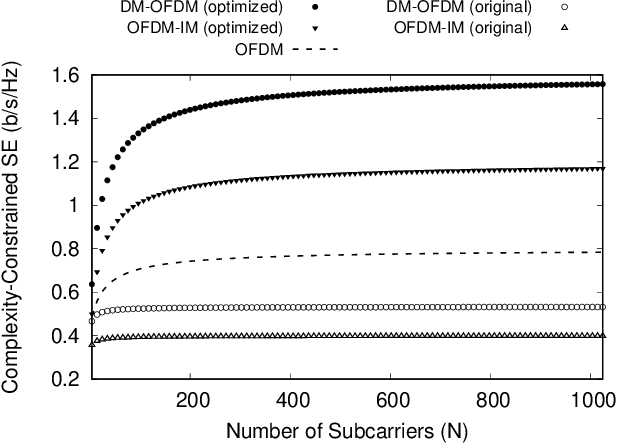
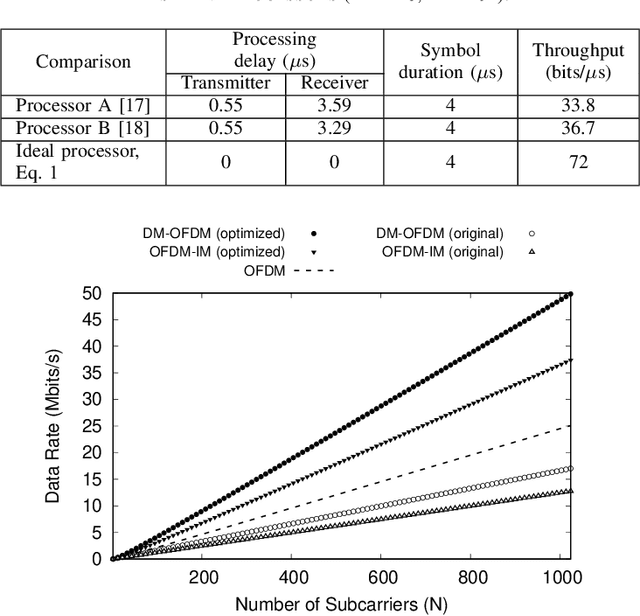
Abstract:In this work, we present a tutorial on how to account for the computational time complexity overhead of signal processing in the spectral efficiency (SE) analysis of wireless waveforms. Our methodology is particularly relevant in scenarios where achieving higher SE entails a penalty in complexity, a common trade-off present in 6G candidate waveforms. We consider that SE derives from the data rate, which is impacted by time-dependent overheads. Thus, neglecting the computational complexity overhead in the SE analysis grants an unfair advantage to more computationally complex waveforms, as they require larger computational resources to meet a signal processing runtime below the symbol period. We demonstrate our points with two case studies. In the first, we refer to IEEE 802.11a-compliant baseband processors from the literature to show that their runtime significantly impacts the SE perceived by upper layers. In the second case study, we show that waveforms considered less efficient in terms of SE can outperform their more computationally expensive counterparts if provided with equivalent high-performance computational resources. Based on these cases, we believe our tutorial can address the comparative SE analysis of waveforms that operate under different computational resource constraints.
Maximum Channel Coding Rate of Finite Block Length MIMO Faster-Than-Nyquist Signaling
Mar 13, 2024Abstract:The pursuit of higher data rates and efficient spectrum utilization in modern communication technologies necessitates novel solutions. In order to provide insights into improving spectral efficiency and reducing latency, this study investigates the maximum channel coding rate (MCCR) of finite block length (FBL) multiple-input multiple-output (MIMO) faster-than-Nyquist (FTN) channels. By optimizing power allocation, we derive the system's MCCR expression. Simulation results are compared with the existing literature to reveal the benefits of FTN in FBL transmission.
Category-wise Fine-Tuning: Resisting Incorrect Pseudo-Labels in Multi-Label Image Classification with Partial Labels
Jan 30, 2024



Abstract:Large-scale image datasets are often partially labeled, where only a few categories' labels are known for each image. Assigning pseudo-labels to unknown labels to gain additional training signals has become prevalent for training deep classification models. However, some pseudo-labels are inevitably incorrect, leading to a notable decline in the model classification performance. In this paper, we propose a novel method called Category-wise Fine-Tuning (CFT), aiming to reduce model inaccuracies caused by the wrong pseudo-labels. In particular, CFT employs known labels without pseudo-labels to fine-tune the logistic regressions of trained models individually to calibrate each category's model predictions. Genetic Algorithm, seldom used for training deep models, is also utilized in CFT to maximize the classification performance directly. CFT is applied to well-trained models, unlike most existing methods that train models from scratch. Hence, CFT is general and compatible with models trained with different methods and schemes, as demonstrated through extensive experiments. CFT requires only a few seconds for each category for calibration with consumer-grade GPUs. We achieve state-of-the-art results on three benchmarking datasets, including the CheXpert chest X-ray competition dataset (ensemble mAUC 93.33%, single model 91.82%), partially labeled MS-COCO (average mAP 83.69%), and Open Image V3 (mAP 85.31%), outperforming the previous bests by 0.28%, 2.21%, 2.50%, and 0.91%, respectively. The single model on CheXpert has been officially evaluated by the competition server, endorsing the correctness of the result. The outstanding results and generalizability indicate that CFT could be substantial and prevalent for classification model development. Code is available at: https://github.com/maxium0526/category-wise-fine-tuning.
Distance Guided Generative Adversarial Network for Explainable Binary Classifications
Dec 29, 2023Abstract:Despite the potential benefits of data augmentation for mitigating the data insufficiency, traditional augmentation methods primarily rely on the prior intra-domain knowledge. On the other hand, advanced generative adversarial networks (GANs) generate inter-domain samples with limited variety. These previous methods make limited contributions to describing the decision boundaries for binary classification. In this paper, we propose a distance guided GAN (DisGAN) which controls the variation degrees of generated samples in the hyperplane space. Specifically, we instantiate the idea of DisGAN by combining two ways. The first way is vertical distance GAN (VerDisGAN) where the inter-domain generation is conditioned on the vertical distances. The second way is horizontal distance GAN (HorDisGAN) where the intra-domain generation is conditioned on the horizontal distances. Furthermore, VerDisGAN can produce the class-specific regions by mapping the source images to the hyperplane. Experimental results show that DisGAN consistently outperforms the GAN-based augmentation methods with explainable binary classification. The proposed method can apply to different classification architectures and has potential to extend to multi-class classification.
A Parameterized Generative Adversarial Network Using Cyclic Projection for Explainable Medical Image Classification
Dec 07, 2023
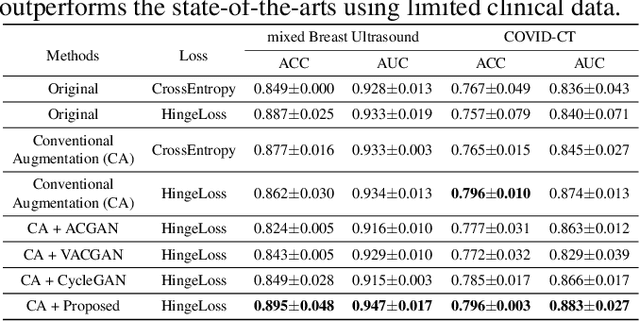

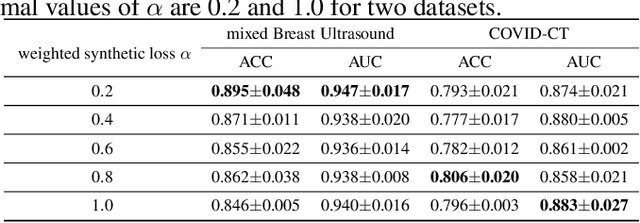
Abstract:Although current data augmentation methods are successful to alleviate the data insufficiency, conventional augmentation are primarily intra-domain while advanced generative adversarial networks (GANs) generate images remaining uncertain, particularly in small-scale datasets. In this paper, we propose a parameterized GAN (ParaGAN) that effectively controls the changes of synthetic samples among domains and highlights the attention regions for downstream classification. Specifically, ParaGAN incorporates projection distance parameters in cyclic projection and projects the source images to the decision boundary to obtain the class-difference maps. Our experiments show that ParaGAN can consistently outperform the existing augmentation methods with explainable classification on two small-scale medical datasets.
MIMO Asynchronous MAC with Faster-than-Nyquist (FTN) Signaling
May 20, 2023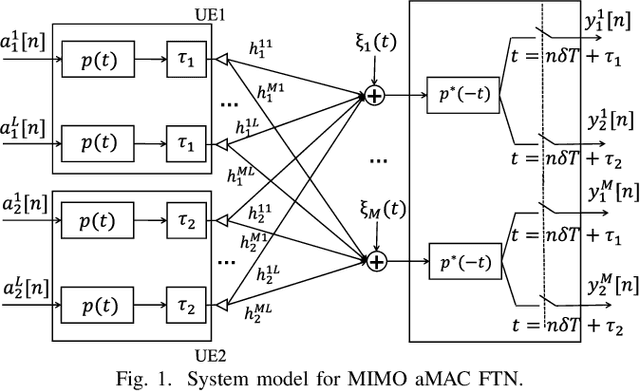
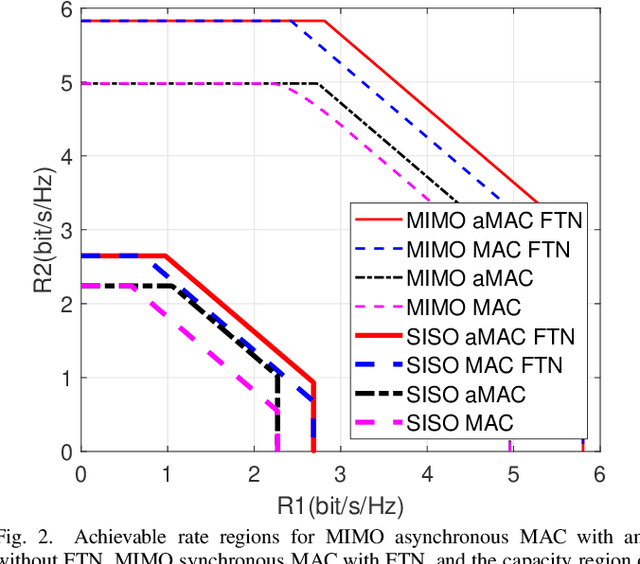
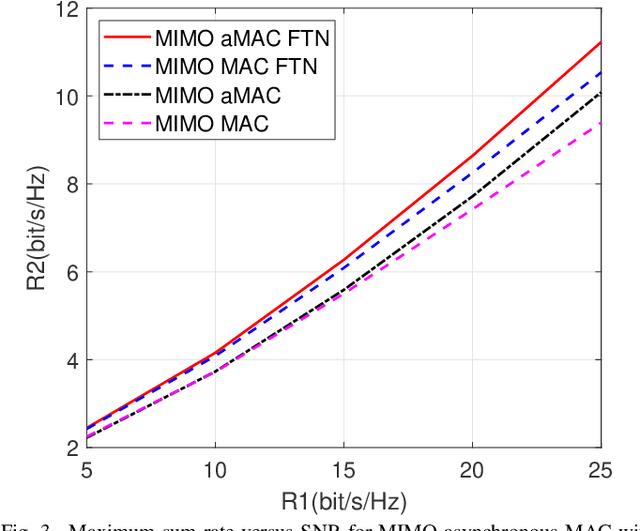

Abstract:Faster-than-Nyquist (FTN) signaling is a nonorthogonal transmission technique, which brings in intentional inter-symbol interference. This way it can significantly enhance spectral efficiency for practical pulse shapes such as the root raised cosine pulses. This paper proposes an achievable rate region for the multiple antenna (MIMO) asynchronous multiple access channel (aMAC) with FTN signaling. The scheme applies waterfilling in the spatial domain and precoding in time. Waterfilling in space provides better power allocation and precoding helps mitigate inter-symbol interference due to asynchronous transmission and FTN. The results show that the gains due to asynchronous transmission and FTN are more emphasized in MIMO aMAC than in single antenna aMAC. Moreover, FTN improves single-user rates, and asynchronous transmission improves the sum-rate, due to better inter-user interference management.
Bit-Interleaved Multiple Access: Improved Fairness, Reliability, and Latency for Massive IoT Networks
Apr 12, 2023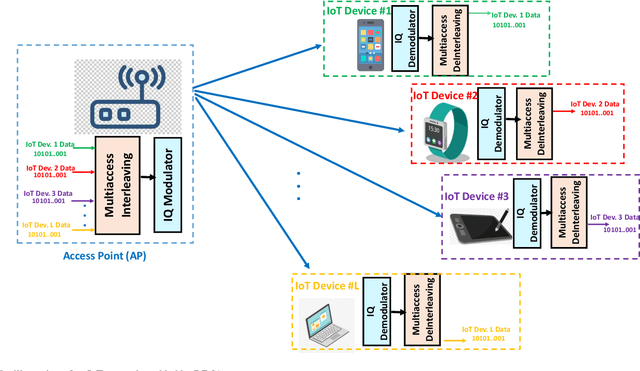
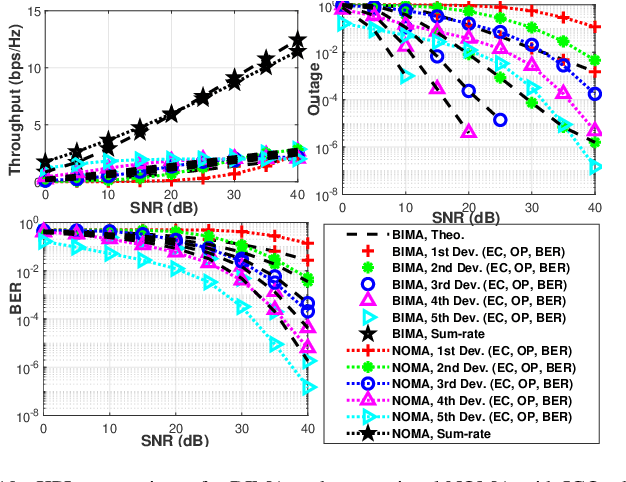
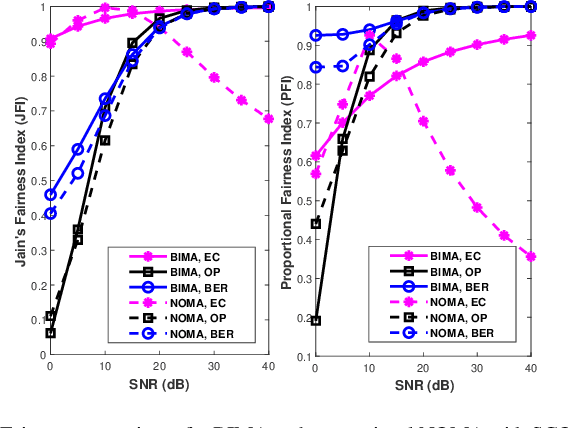
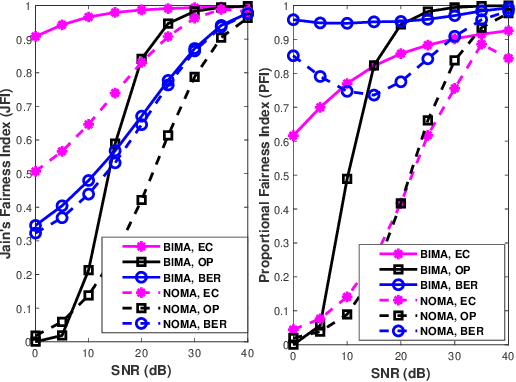
Abstract:In this paper, we propose bit-interleaved multiple access (BIMA) to enable Internet-of-Things (IoT) networks where a massive connection is required with limited resource blocks. First, by providing a true power allocation (PA) constraint for conventional NOMA with practical constraints, we demonstrate that it cannot support massive connections. To this end, we propose BIMA where there are no strict PA constraints, unlike conventional NOMA, thus allowing a high number of devices. We provide a comprehensive analytical framework for BIMA for all key performance indicators (KPIs) (i.e., ergodic capacity [EC], outage probability [OP], and bit error rate [BER]). We evaluate Jain's fairness index and proportional fairness index in terms of all KPIs. Based on the extensive computer simulations, we reveal that BIMA outperforms conventional NOMA significantly, with a performance gain of up to 20-30dB. This performance gain becomes greater when more devices are supported. BIMA provides a full diversity order and enables the implementation of an arbitrary number of devices and modulation orders, which is crucial for IoT networks in dense areas. BIMA guarantees a fairness system where none of the devices gets a severe performance and the sum-rate is shared in a fair manner among devices by guarantying QoS satisfaction. Finally, we provide an intense complexity and latency analysis and demonstrate that BIMA provides lower latency compared to conventional NOMA since it allows parallel computing at the receivers and no iterative operations are required. We show that BIMA reduces latency by up to 350\% for specific devices and 170\% on average.
 Add to Chrome
Add to Chrome Add to Firefox
Add to Firefox Add to Edge
Add to Edge